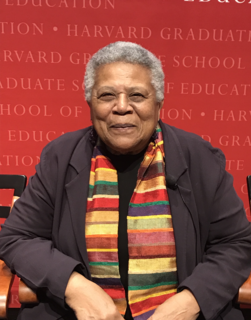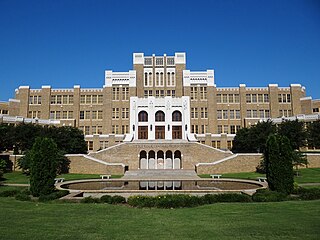 W
WOn May 17, 1954, the U.S Supreme Court ruled that racial segregation of public schools was unconstitutional in the United States. That ruling would focus the spotlight of national attention in the United States upon the Arkansas National Guard and the integration of Central High School. The Arkansas National Guard was drawn into the conflict when Governor Orval Faubus ordered them to "Preserve the Peace" by turning away the black students who were attempting to integrate into Little Rock's Central High School. United States President Dwight D. Eisenhower reacted to this use of the Guard to foil the court-ordered integration by federalizing the entire Arkansas National Guard and using it to protect the nine black students integrating Central High School.
 W
WDaisy Bates was an American civil rights activist, publisher, journalist, and lecturer who played a leading role in the Little Rock Integration Crisis of 1957.
 W
WThe Daisy Bates House is a historic house at 1207 West 28th Street in Little Rock, Arkansas, USA. It is significant as the home of Arkansas NAACP president Daisy Bates, and for its use as a command post for those working to desegregate the Little Rock Central High School during the desegregation crisis of 1957–1958. It was a sanctuary for the nine students involved. It was declared a National Historic Landmark in 2001.
 W
WMelba Joy Pattillo Beals is an American journalist and college educator who is widely known as a member of the Little Rock Nine, a group of African-American students who were the first to integrate Little Rock Central High School in Little Rock, Arkansas.
 W
WMinnijean Brown-Trickey is a political figure who was a member of the Little Rock Nine, a group of nine African American teenagers who integrated Little Rock Central High School. The integration followed the Brown v. Board of Education decision which required public schools to be desegregated.
 W
WLittle Rock Central High School (LRCHS) is an accredited comprehensive public high school in Little Rock, Arkansas, United States. The school was the site of forced desegregation in 1957 after the U.S. Supreme Court ruled that segregation of public schools was unconstitutional three years earlier. This was during the period of heightened activism in the civil rights movement.
 W
WElizabeth Ann Eckford is one of the Little Rock Nine, a group of African-American students who, in 1957, were the first black students ever to attend classes at Little Rock Central High School in Little Rock, Arkansas. The integration came as a result of Brown v. Board of Education. Eckford's public ordeal was captured by press photographers on the morning of September 4, 1957, after she was prevented from entering the school by the Arkansas National Guard. A dramatic snapshot by Johnny Jenkins of the United Press (UP) showed the young girl being followed and threatened by an angry white mob; this and other photos of the day's startling events were circulated around the US and the world by the press.
 W
WThe Ernest Green Story is a 1993 American made-for-television biographical film which follows the true story of Ernest Green and eight other African-American high-school students as they embark on their historic journey to integrate Little Rock Central High School in Little Rock, Arkansas, in 1957. The film was developed and executive produced by Carol Ann Abrams. Much of the movie was filmed on location at Central High School.
 W
WErnest Gideon Green is one of the Little Rock Nine, a group of African-American students who, in 1957, were the first black students ever to attend classes at Little Rock Central High School in Little Rock, Arkansas. Green was the first African-American to graduate from the school in 1958. In 1999, he and the other members of the Little Rock Nine were awarded the Congressional Gold Medal by President Bill Clinton.
 W
WCarlotta Walls LaNier is the youngest of the Little Rock Nine, a group of African-American students who, in 1957, were the first black students ever to attend classes at Little Rock Central High School in Little Rock, Arkansas, United States. She was the first black female to graduate from Central High School. In 1999, LaNier and the rest of the Little Rock Nine were awarded the Congressional Gold Medal by President Bill Clinton. LaNier was inducted into the Colorado Women's Hall of Fame in 2004 and the National Women's Hall of Fame in 2015.
 W
WThelma Mothershed-Wair is the eldest member of the Little Rock Nine group who attended Little Rock's Central High School following the 1954 Brown vs. Board of Education court case. The Little Rock Nine was a group of nine African American students enrolled in Little Rock Central High School in 1957. Their enrollment was followed by the Little Rock Crisis, in which the students were initially prevented from entering the racially segregated school by Orval Faubus, the Governor of Arkansas. They then attended after the intervention of President Dwight D. Eisenhower.
 W
WTerrence James Roberts is one of the Little Rock Nine, a group of African-American students who, in 1957, were the first black students ever to attend classes at Little Rock Central High School in Little Rock, Arkansas. In 1999, he and the other people of the Little Rock Nine were awarded the Congressional Gold Medal by President Bill Clinton.
 W
WAdolphine Fletcher Terry (1882–1976) was an American political and social activist in the state of Arkansas. Terry leveraged her position within the Little Rock community to affect change in causes related to social justice, women's rights, racial equality, housing, and education. Fletcher is most remembered for her role on the Women's Emergency Committee to Open Our Schools (WEC) that was primarily responsible for reopening the Little Rock, Arkansas, public school system and bringing to a close the school district closing in 1958, following the Crisis at Little Rock Central High. In its "Millennium Poll" in 2000, the Arkansas Historical Association named Terry one of the state's 15 most significant figures in state history.